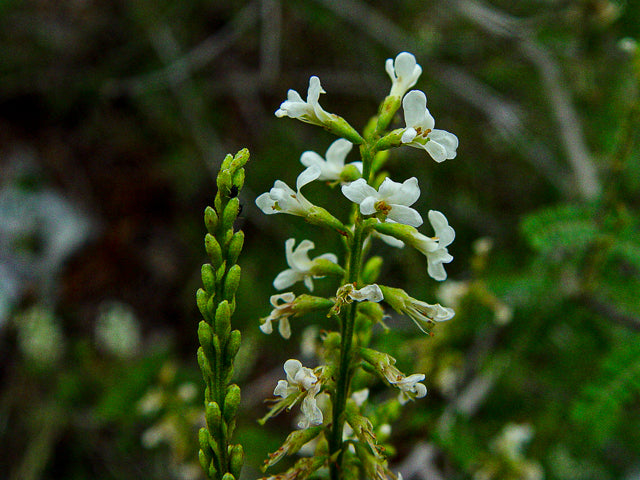Texas Kidneywood (Eysenhardtia texana)
Texas Kidneywood (Eysenhardtia texana)
Low stock: 10 left
Couldn't load pickup availability
Eysenhardtia texana Scheele
Texas Kidneywood, Kidneywood, Bee Brush, Vara Dulce, Palo Dulce
Fabaceae (Pea Family)
Synonym(s): Eysenhardtia angustifolia
USDA Symbol: EYTE
Texas kidneywood is an unarmed, much-branched shrub, 3-10 ft. tall, with an open, airy structure and gland-dotted, aromatic, resinous leaves and flowers. Its spikes of white flowers are fragrant, as are the deciduous, finely divided leaves. Leaves up to 3-1/2 inches long, consisting of a central axis and as many as 40 small leaflets, each from about 1/4 - 1/2 inch long, pungent when crushed. Flowers white, small, with a delicate fragrance, arranged in spikes up to 4-1/2 inches long at the ends of branchlets, appearing intermittently from May to October, especially after rains. Fruit a pod about 3/8 inch long, often with a threadlike tip. Seed pods are somewhat persistent.
Leaves and leaflets vary considerably in size, from plant to plant and sometimes on the same plant. Leaflets may vary from under 1/4 inch long on branches in full sun, to more than 1/2 inch long in shaded situations. (PERS.OBS)
This tree and its relative, the more westerly E. orthocarpa, were once used in remedies for kidney and bladder ailments, hence the name.
Plant Characteristics
Habit: Shrub
Leaf Retention: Deciduous
Leaf Arrangement: Alternate
Fruit Type: Legume
Size Notes: Up to about 10 feet tall.
Bloom Time: May , Jun , Jul , Aug , Sep , Oct
Distribution
USA: TX
Native Distribution: Central and south TX, n. to Bell, San Saba, Crockett & Brewster Cos. & s. to central Mex.
Native Habitat: Frequent in brushy vegetation in Rio Grande Plains, Central and West Texas. Well-drained sand, loam, clay, caliche, limestone. Dry, brushy hills & canyons
Growing Conditions
Water Use: Low
Light Requirement: Sun
Soil Moisture: Dry
Cold Tolerant: yes
Heat Tolerant: yes
Soil Description: Dry, rocky, calcareous soils. Sandy, Sandy Loam, Medium Loam, Clay Loam, Clay, Limestone-based, Caliche type
Conditions Comments: Kidneywood foliage has a pungent, citrusy smell. Bees flock to the ambrosial flowers, which bloom at intervals through the warm months. The Dogface butterfly also eats kidneywood as larval food. Can create a small tree with proper pruning. May temporarily lose leaves during a dry spell. Drought-tolerant.
Benefit
Use Ornamental: Aromatic, Accent tree or shrub, Blooms ornamental, Fast growing, Showy
Use Wildlife: Flowers attract bees and butterflies
Use Food: It is very palatable and is readily grazed by white-tailed deer and goats.
Use Other: The wood has been used for dyes and is fluorescent in water.
Conspicuous Flowers: yes
Fragrant Flowers: yes
Fragrant Foliage: yes
Attracts: Butterflies
Larval Host: Dogface butterfly
Nectar Source: yes
Image Information
Photographer: Newsom, Charles RayCity: Georgetown
County: Williamson
State: TX
Location Notes: Blue Hole Park. Downstream area.
Accession date: 2025-02-20
Filename: CRN_IMG03771.JPG
Slide Index: Eysenhardtia_texana_05_side.JPG
Restrictions: Unrestricted
Collection: Wildflower Center Digital Library
Original Format: Digital
Orientation: Landscape
Shot: Close-up of an inflorescence.
Date Taken: 2014-09-13
NPIN Image Id: 137839


